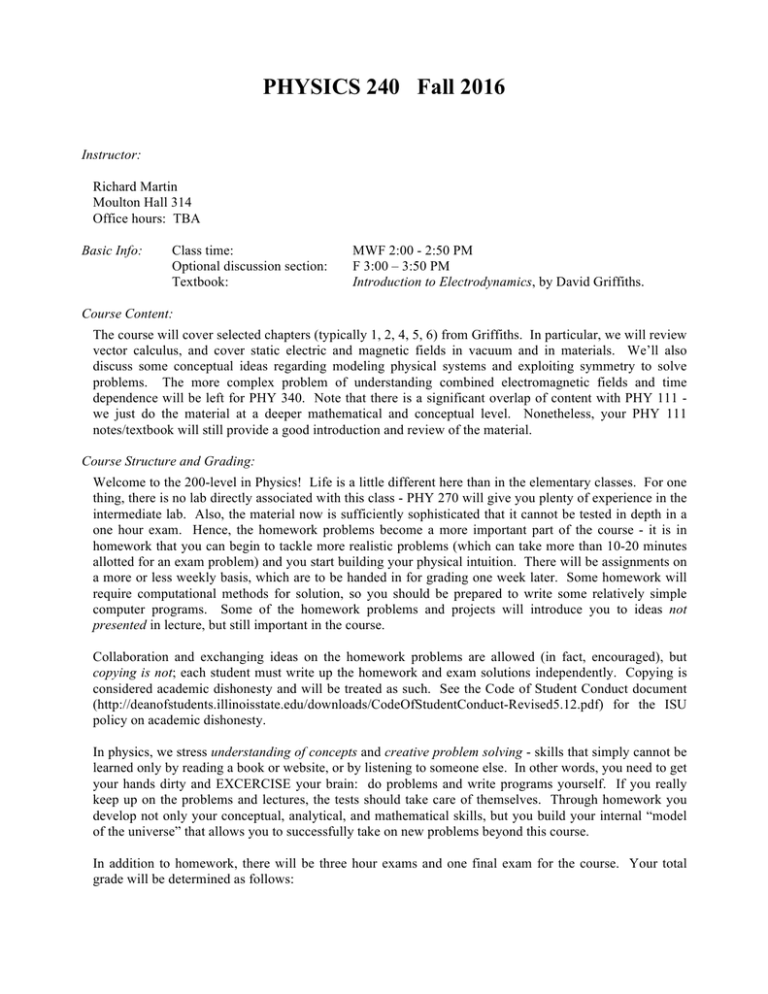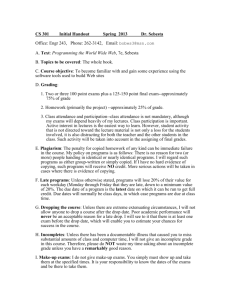PHYSICS 240 Fall 2016 - Illinois State University
advertisement

PHYSICS 240 Fall 2016 Instructor: Richard Martin Moulton Hall 314 Office hours: TBA Basic Info: Class time: Optional discussion section: Textbook: MWF 2:00 - 2:50 PM F 3:00 – 3:50 PM Introduction to Electrodynamics, by David Griffiths. Course Content: The course will cover selected chapters (typically 1, 2, 4, 5, 6) from Griffiths. In particular, we will review vector calculus, and cover static electric and magnetic fields in vacuum and in materials. We’ll also discuss some conceptual ideas regarding modeling physical systems and exploiting symmetry to solve problems. The more complex problem of understanding combined electromagnetic fields and time dependence will be left for PHY 340. Note that there is a significant overlap of content with PHY 111 we just do the material at a deeper mathematical and conceptual level. Nonetheless, your PHY 111 notes/textbook will still provide a good introduction and review of the material. Course Structure and Grading: Welcome to the 200-level in Physics! Life is a little different here than in the elementary classes. For one thing, there is no lab directly associated with this class - PHY 270 will give you plenty of experience in the intermediate lab. Also, the material now is sufficiently sophisticated that it cannot be tested in depth in a one hour exam. Hence, the homework problems become a more important part of the course - it is in homework that you can begin to tackle more realistic problems (which can take more than 10-20 minutes allotted for an exam problem) and you start building your physical intuition. There will be assignments on a more or less weekly basis, which are to be handed in for grading one week later. Some homework will require computational methods for solution, so you should be prepared to write some relatively simple computer programs. Some of the homework problems and projects will introduce you to ideas not presented in lecture, but still important in the course. Collaboration and exchanging ideas on the homework problems are allowed (in fact, encouraged), but copying is not; each student must write up the homework and exam solutions independently. Copying is considered academic dishonesty and will be treated as such. See the Code of Student Conduct document (http://deanofstudents.illinoisstate.edu/downloads/CodeOfStudentConduct-Revised5.12.pdf) for the ISU policy on academic dishonesty. In physics, we stress understanding of concepts and creative problem solving - skills that simply cannot be learned only by reading a book or website, or by listening to someone else. In other words, you need to get your hands dirty and EXCERCISE your brain: do problems and write programs yourself. If you really keep up on the problems and lectures, the tests should take care of themselves. Through homework you develop not only your conceptual, analytical, and mathematical skills, but you build your internal “model of the universe” that allows you to successfully take on new problems beyond this course. In addition to homework, there will be three hour exams and one final exam for the course. Your total grade will be determined as follows: Exams Final Exam Homework 50% 15% 35% The hour exams will test both problem solving ability as well as conceptual understanding of the material. You will be allowed to bring to the exams one 8.5" x 11" sheet of paper with formulas (or whatever) written on it. Electronic devices such as computers, calculators, phones, etc. are not allowed in exams. Course Grade: In this course grades are not artificially restricted to the range 50-100%, as they are in many courses. If you do about half the work expected on a test or homework problem, you can expect to get about half credit (50%); If you do a quarter of the work, expect a grade near 25%. The effect of this is that number grades tend look “low” compared to classes you might be used to, in which averages are engineered to be about 75%. Based on previous PHY 240 classes that I’ve taught, the following grade boundaries will be “guaranteed”, in the sense that your are guaranteed to get at least the letter grades listed below for total point ranges given: A B C D 87 - 100 74 - 86.999 54 - 73.999 45 - 53.999 The final grade boundaries are typically close to these minimum guaranteed grade boundaries. The lower boundary for a given letter grade will never be higher than these. If you simply must know your grade based on the 90-80-70-60 model of grade boundaries, it’s not difficult to construct a scaling procedure to transform your grade into this range (in fact, that’s what many instructors do in order to force their grades into this range.) If you can’t figure out a way to do this, feel free to stop by during office hours and we can work out an algorithm. Late homework and absences: You'll usually have one week for homework. That's plenty of time, as long as you don't wait until the night before the due date. Early homeworks (in Dept. Office by 4:30 the day before the due date) earn a 5% bonus and late homework will lose 10% per day late. However, you should always hand in any work you have done, to receive partial credit - don't feel that if you didn't get that integral or computer program to work perfectly that your efforts are worth nothing: 35% is a lot better than zero... For obvious reasons, No homework will be accepted after the solutions have been posted. To account for possible absences or illness, the lowest homework score and test score will be dropped. Make-up exams will be allowed only if one exam has already been missed and then only for excused absences due to illness, serious illness or death in your immediate family, or other significant reasons. Make-up exams will not be the same exam as given in class. For example, a makeup exam might usually contain problems from other textbooks that are similar to those on the regular classroom exam. No other projects or papers will be allowed as make-up or extra credit. Absences due to Student Bereavement. Students who experience the death of an immediate family member or relative as defined in the University Student Bereavement Policy will be excused from class for funeral leave, subsequent bereavement, and/or travel considerations. Students are responsible for providing appropriate documentation to the Dean of Students office and for contacting the instructor as soon as possible to make arrangements for completing missed work. Note on Homework: Homework at the intermediate level in physics is different than your introductory courses. Problems will take more preparatory thought and will almost certainly take longer to work through. I also expect you to provide English words of explanation for your work. A couple equations and a number are insufficient for most problems. I do expect complete sentences, organized thoughts, and using equations as part of a sentence. I’m trying to get you to learn to think, and in order to assess that I need to see your reasoning. Computational homework is similar but also requires analysis of your simulation code and results. Graphs and other kinds of visualization methods are usually necessary to get your point across. Help! Intermediate physics courses can be challenging, and you learn best by working with others - including the instructor. The course has an optional discussion section, which will be used mostly for sample problem solving. You are encouraged to come for help or general discussion during office hours. In particular, don't beat your head against the wall on a homework or computer problem you are stuck on. More often than not a few words of explanation can clear up the block. If you cannot make the scheduled hours, feel free to make an appointment with me or stop by and try your luck -- I’m frequently available. As a final note I’ll mention that a few years ago I received the “Mayhaps” award from the Physics Club based on my style of “answering” questions with a question. I could tell you the rote answer to your question over and over again, but you’ll never learn it until you work it out yourself. Therefore I will steer you in right direction so you can get there yourself. Try it -- you’ll like it! PHYSICS 240 Typical Course Content 0. Some Background (1 class + as needed) • • • I. The 4 theories of physics The place of E&M in physics Why E&M is “difficult” Math Review • • • Vector functions and operators; div, grad, curl (2-3 classes) Line, surface, volume integrals; relation to derivatives (3) Dirac delta functions: math and physical meaning (2) II. Electrostatics in Vacuum • • • • • • • Coulomb’s law and electric field; E field visualization (3) Gauss’ Law and symmetry (3) Electric potential (3) Electrical work and energy (1) Boundary conditions and conductors (1) Multipole expansion (2) Laplace’s equation and over-relaxation method (3) III. Electrostatics in matter • • • Atomic polarizibilty, susceptibility, and polarization (3) Dielectric constant and D (1) Generalization of Gauss’ Law, work and energy (3) IV. Magnetostatics • • • • • • • Current and Ohm’s law (2) Biot-Savart law (3) Magnetic force (1) Ampere’s law (2) Vector potential (2) Magnetic dipole expansion (1) Magnetic fields in matter (3) Comments on "Collaboration" In the syllabus for the course, it is stated that "Collaboration and exchanging ideas on the homework problems is allowed, but copying is not." What does that mean? This summary is intended to clarify the meanings of these words a bit: Collaboration includes: • Two or more students actively working on a problem together, each contributing ideas, each working out possible solutions. Different people have different skills and collaboration can benefit all. When an outline of the solution to the problem is determined, each student then works it out fully and writes it up separately. • General discussion of homework problems, which might include one student giving a hint to another on the solution of a problem. • One student helping another with general programming: e.g. figuring out the algorithm, syntax, or graphics software. Collaboration does NOT include: • One student writing up a problem solution, then another student copying it. This is pretty blatant cheating. • Splitting the work: e.g., one person does problem A and another does problem B, then sharing the results. • Copying a completed computer program or homework solution from one student account or laptop to another. • Two or more students working on problems together, but one student rarely making a contribution, simply letting the others work out the solution. • Copying online solutions to problems. You can find solutions to all the textbook problems online, which is why I don’t assign them for a grade. But even the ones I do assign are similar, and parts of their solution may be available: just don’t do it. Copying is cheating can lead to disciplinary action - including dismissal from the university. It’s not worth the risk. But really more important: it doesn't do you much good in the long run! If you don't do the homework yourself, you simply won't learn the concepts, material, or methods! Not learning will have consequences on your grades in college and on your ability to succeed after graduation. All technical careers require you to think independently while contributing to a group effort. « Learn by doing, in collaboration with peers « ✗ NEVER hand in anyone else’s work as your own ✗

